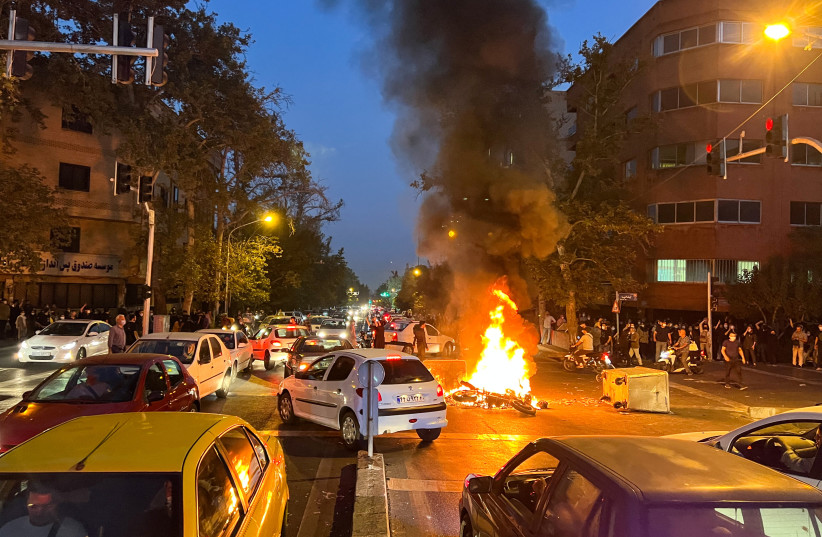Iran has been trying to quell protesters for two months after they took to the streets following the Iranian police killing of Jina Mahsa Amini in mid-September.
Amini was detained and accused of not wearing a headscarf properly. Protests initially broke out in the Kurdish region of northwest Iran because she was Kurdish. However, the protests quickly spread to Tehran and then the whole country.
For weeks, Iran’s security forces and police attempted to confront the protests using non-lethal methods. This is in contrast to several years ago when Iran massacred protesters. With some exceptions, such as in Balochistan, Iran didn’t use live fire. Police were sometimes sent in with paintball guns and other types of weapons.
Iran’s regime knew it was facing a huge wave of anger and that its targeting of women was setting off a powderkeg. The regime decided early on to try to neutralize minority groups so that the protests could be stopped where they began in the Kurdish region, and also in southeast Iran’s Balochistan region. Iran fired missiles at Kurdish opposition groups in Iraq in late September.
But Iran’s failure is clear. This week it again attacked Kurdish groups in Iraq and the regime alleges that dozens of Kurdish activists have crossed into Iran to confront the regime. At the same time, the regime has antagonized Azerbaijan, and it continually claims its adversaries are backed by “Zionists.” But this propaganda appears to be wearing thin.

Iran can't control the continued protests
Iran can’t control the continued protests. In fact, the regime thought that the protests might end 40 days after Amini’s death; hoping that the traditional mourning period would bring them to an end on October 26. The regime was wrong, the protests are continuing.
It is hard to quantify the protests, but videos posted from Iran appear to show protests across the country and continued attacks on symbols of the regime. This includes recent videos of people chanting “death” the authorities, ransacking or firebombing government offices, burning the flags of Iran’s various IRGC proxies; or attacking statues and other visible evidence of the regime. For instance, images of the Supreme Leader Ayatollah Khamenei are often seen on fire. Some of the protests have also taken place in smaller towns; showing that this is an awakening across the country and the regime doesn’t have enough forces to deal with all the protests.
Nevertheless, the crackdown continues. Live fire can be heard in some recent videos and some 15,000 people have been detained. While rumors that Iran wants to execute all the detainees have been exaggerated, the regime nevertheless looks to continue to detain people and will kill some of them.
Another problem for Iran is that it may be facing pressure economically from other sectors of society, such as merchants or workers in the energy sector. It is difficult to confirm the full extent of what sectors have joined the protests or gone on strike, but it does seem the authorities are not in control of parts of the country, especially after night fall.
Iran is also facing challenges abroad. Iran joined the UN’s so-called “UN Commission on the Status of Women (CSW)” in March but now there are calls for the regime to be removed. Iran has faced unprecedented critique abroad, especially from Western countries.
This kind of critique is unusual for the regime. In the past, Tehran could count on using western media to tell stories about “moderates” and it could send its then foreign minister Javad Zarif to Europe or the US where he would be greeted with smiles and hold court. But today, Zarif is gone and Iran can’t get the same attention from any Western country.
Iran’s ability also to mobilize lobby groups in the West, the kind that would write op-eds about the need to empower the “moderates” or create a new “deal” with Iran, has diminished. Many voices who in the past use to advocate for some kind of understanding with the regime are now supportive of the protests. The regime seems to have gone one step too far. It is also making missteps in its arming of Russia with drones, which has angered the West, and its antagonistic attitude toward the Gulf and Azerbaijan.
On November 15 the US Department of the Treasury’s Office of Foreign Assets Control (OFAC) said it was “sanctioning firms involved in the production or ongoing transfer to Russia of Iranian unmanned aerial vehicles (UAVs), which Russia has used in devastating attacks against civilian infrastructure in Ukraine.”
Iran is thus facing an unprecedented series of challenges, on the diplomatic, military and domestic front. It’s inability to juggle all of these problems is clear. The fact that it continues to lash out at Kurdish groups, using missiles to attack Koya and other areas in the Kurdistan region of Iraq, is evidence that it feels threatened. The question is whether the protests can reach the next step. They have illustrated their ability to stay in the streets.
Critics of the protests have pointed out that they are leaderless and don’t have a real program in place; and that regimes like the one in Tehran won’t likely be toppled by protests. That is where the crux of the problem lies. Iran can’t defeat the protests. But the protests don’t seem like they can defeat the regime either.
